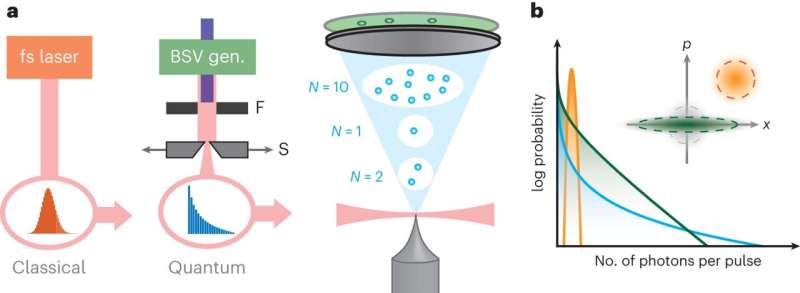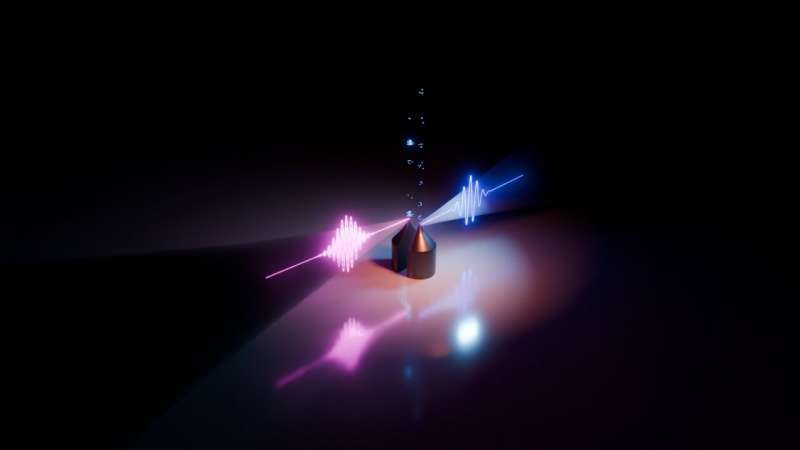
Experimental scheme. Credit: Nature Physics (2024). DOI: 10.1038/s41567-024-02472-6
Strong field quantum optics is a rapidly emerging research topic, which merges elements of non-linear photoemission rooted in strong field physics with the well-established realm of quantum optics. While the distribution of light particles (i.e., photons) has been widely documented both in classical and non-classical light sources, the impact of such distributions on photoemission processes remains poorly understood.
Researchers at Friedrich-Alexander-Universität Erlangen-Nürnberg (FAU) and the Max Planck Institute for the Science of Light recently set out to fill this gap in the literature, by exploring the interactions between light and matter with a non-classical light source. Their paper, published in Nature Physics, demonstrates that photon statistics of the driving light source are imprinted on the electron number statistics of emitted electrons from metal needle tips, an observation that could have interesting implications for the future development of optical devices.
“The field of strong field physics is now highly developed, as apparent from the 2023 Nobel prize in Physics,” Jonas Heimerl, co-author of the paper and researcher at FAU, told Phys.org. “This physics is not limited to atoms but also happening at metal surfaces like metal needle tips. Similarly developed and even more diverse is the field of quantum optics. One aspect of this field is the generation of light with non-classical light statistics, such as bright squeezed vacuum.”
The primary objective of the latest research by Heimerl and his collaborators has been to understand how quantum light originating from non-classical light sources interacts with matter. Notably, the interactions between quantum light and matter have so far only been explored using classical light sources.
“Our next-door neighbor Professor Maria Chekhova is a world-leading expert in the field of bright squeezed vacuum generation, a particular form of non-classical light,” Peter Hommelhoff, co-author of the paper and researcher at FAU, told Phys.org. “We thus teamed up with her and our long-time partner Ido Kaminer of the Technion in Israel to investigate electron emission driven with non-classical light.”
Heimerl, Hommelhoff and their research group at FAU carried out their experiments in close collaboration with Chekhova, a researcher with extensive expertise in quantum optics. Chekhova is specifically known for her work on bright squeezed vacuum generation, a technique that entails the use of non-linear optical processes to generate bright squeezed vacuum, a form of non-classical light.

Artist’s impression of the two-emission regime: a non-classical (purple) and a classical (blue) light source trigger nonlinear photoemission from a metal needle tip, leading to different statistics of the emitted electrons. Image credit: Meier, Heimerl | Laser Physics | FAU Erlangen.
“In our experiment, we used this non-classical light source to trigger a photoemission process from a metal needle tip that is only a few tens of nanometers in size,” Heimerl explained. “Think of it as the well-known photoelectric effect studied by Einstein, but now with a light source that exhibits extreme intensities and extreme fluctuations within each laser pulse.”
For every laser pulse generated, the researchers counted the number of electrons, both for classical and non-classical light sources. Interestingly, they found that the number of electrons can be directly influenced by the driving light.
“Our findings could be of huge interest, especially for imaging applications with electrons, for instance when it comes down to imaging biological molecules,” Heimerl said.
Biological molecules are known to be highly prone to damage and reducing the dose of electrons used to image these molecules could reduce the risk of such damage. The paper by Heimerl et al. suggests that modulating the number of electrons to meet the needs of specific applications is possible.
“Before we can tackle this, however, we have to show that we can also imprint another photon distribution to electrons, namely one with reduced noise, which might be hard to achieve,” Hommelhoff said.
The findings of this recent work could soon open new opportunities for research focusing on strong field quantum optics. Concurrently, they could serve as the basis of new devices, including sensors and strong-field optics that leverage the interaction between quantum light and electrons.
“We think that this is only the beginning of investigating the experimental research in this field,” Heimerl added. “There is already much theoretical work going on, some of which is led by our co-author Ido Kaminer. One observable we didn’t investigate yet but carries much information is the energy of the electron, which could shed even more light on the light-matter interaction.”
More information:
Jonas Heimerl et al, Multiphoton electron emission with non-classical light, Nature Physics (2024). DOI: 10.1038/s41567-024-02472-6.
© 2024 Science X Network
Citation:
Researchers realize multiphoton electron emission with non-classical light (2024, May 18)
retrieved 18 May 2024
from https://phys.org/news/2024-05-multiphoton-electron-emission-classical.html
This document is subject to copyright. Apart from any fair dealing for the purpose of private study or research, no
part may be reproduced without the written permission. The content is provided for information purposes only.
>>> Read full article>>>
Copyright for syndicated content belongs to the linked Source : Phys.org – https://phys.org/news/2024-05-multiphoton-electron-emission-classical.html































